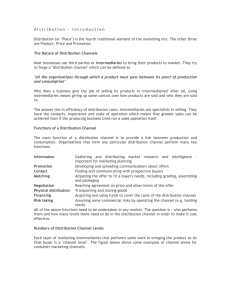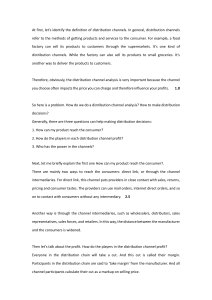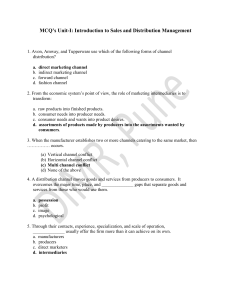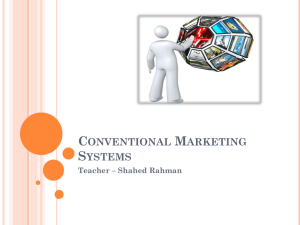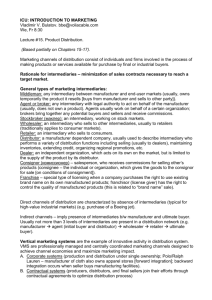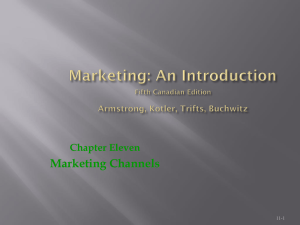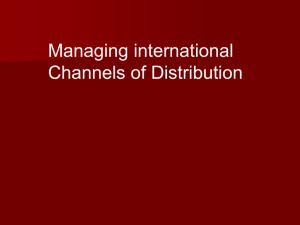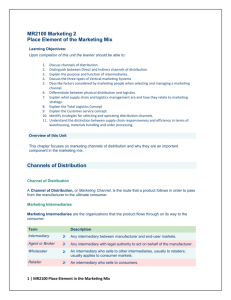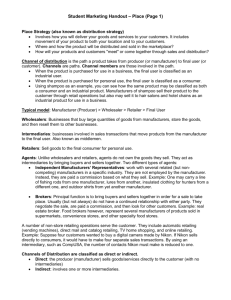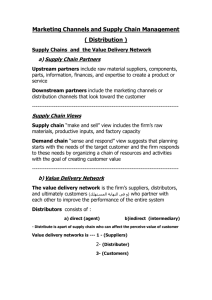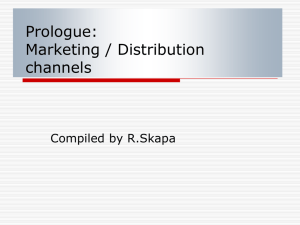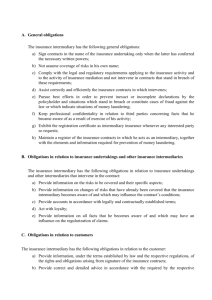disadvantages of using intermediaries in the distribution channel
advertisement
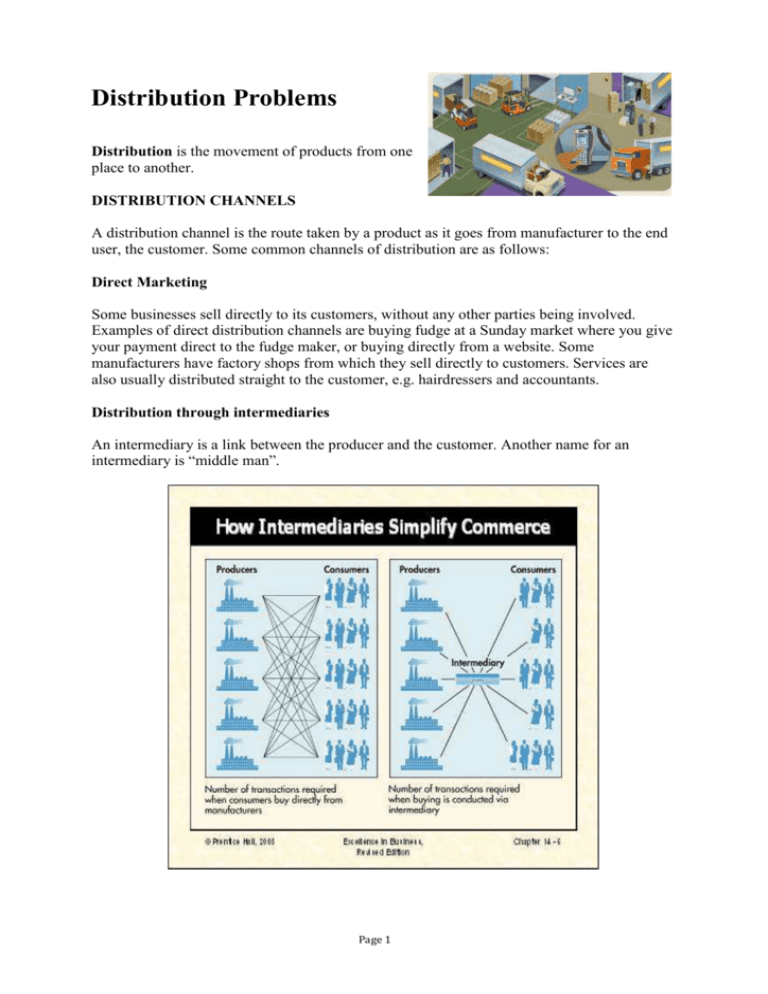
Distribution Problems Distribution is the movement of products from one place to another. DISTRIBUTION CHANNELS A distribution channel is the route taken by a product as it goes from manufacturer to the end user, the customer. Some common channels of distribution are as follows: Direct Marketing Some businesses sell directly to its customers, without any other parties being involved. Examples of direct distribution channels are buying fudge at a Sunday market where you give your payment direct to the fudge maker, or buying directly from a website. Some manufacturers have factory shops from which they sell directly to customers. Services are also usually distributed straight to the customer, e.g. hairdressers and accountants. Distribution through intermediaries An intermediary is a link between the producer and the customer. Another name for an intermediary is “middle man”. Page 1 Retailers buy large quantities from suppliers and sell in smaller quantities to customers. This is of service to the manufacturers who don’t want to sell in small quantities to many consumers, and to consumers who do not want to buy in bulk. Retailers sometimes provide other services that add value to what they sell, for example, home delivery, giftwrapping or repair services. The use of retailers is a one-level distribution channel because the retailer is the one intermediary involved. A wholesaler buys goods from manufacturers and sells them to retailers. The use of wholesalers is an example of a two-level distribution channel. A manufacturer may use an intermediary called an agent or broker. These intermediaries bring buyers and sellers together. Agents are often used when selling into a foreign country. They usually have better knowledge of the laws, needs of consumers and trading conditions in that country. WHAT IS THE BEST DISTRIBUTION CHANNEL FOR A BUSINESS? Various factors must be considered. Nature of the product Is the product complex or technical? Complex products are more likely to be sold by specialist distributors or agents. Is the product customised/made to order? A direct distribution approach is usually best for a product that is made to the customer’s specifications. Desired image for the product ~ if intermediaries are to be used they must be suitable and relevant for the product. The business Its size and scope ~ can it afford an in-house sales force? Its marketing objectives. Does it already have a distribution network, or will this need to be established? How much control does the firm want over distribution? The longer the channel the less control the firm has. The market How geographically spread is the market? Is the market domestic only, or international? Page 2 Extent and nature of the competition ~ which distribution channels and intermediaries do competitors use? Legal issues Are there any limitations on sale? For example, drugs that need a doctor’s prescription can only be sold through pharmacies. What are the risks if an intermediary sells the product to an inappropriate customer? DISADVANTAGES OF USING INTERMEDIARIES IN THE DISTRIBUTION CHANNEL Loss of revenue Intermediaries make a profit for their part in the distribution process. They are either made a direct payment by the manufacturer, e.g. shipping costs plus a mark-up, or they sell the products to retailers at a higher price than they bought the goods from the manufacturer (again, by adding a mark-up). The manufacturer therefore sells the product to the intermediaries at costs lower than the price at which the intermediaries sell to the final customers. A greater profit would be made if the manufacturer been able to manage the distribution. Loss of communication control The manufacturer loses control over what message is being conveyed to the final customers. The reseller may engage in personal selling in order to increase product sales and may possibly exaggerate the benefits of the product. There is potential for miscommunication with end users. Loss of product importance The importance given to a manufacturer’s product by the members of the distribution channel is not under the manufacturer’s control. A competitor’s product may gain greater importance to the intermediary if that business is offering a higher promotional incentive. INVENTORY ISSUES Stock Levels Careful control of stock levels can improve business performance. Having too much stock may mean that money is tied up unproductively, but inadequate stock can lead to delays in production and late deliveries. Efficient inventory control involves finding the right balance between keeping stock levels as low as possible so that costs are minimised, while not allowing stock to run out to the disappointment of customers. Factors that influence stock levels: Demand ~ sufficient stocks need to be kept to satisfy normal demand as well as ‘buffer’ stock held for unforeseen increases in demand or breaks in supply. Stockpiling ~ some firms stockpile stock. For example, confectionary businesses build up stocks of Easter eggs in the few months leading up to Easter. Costs of stock holding ~ stocks of raw materials, components and finished goods occupy space in buildings. The business will also need to pay heating, lighting, insurance and Page 3 other associated costs. Some products may need special storage conditions such as refrigerated facilities for certain food items. Type of stock ~ only small stocks of perishable items can be held. The stock levels of baked goods should be low; ideally the entire stock will be sold in a day. The ‘life’ of stock does not only depend on its perishability. For example, holding high levels of highfashion garments would be unwise as fashions may change and the garments may need to be sold below cost. Available working capital ~ a business that is short of working capital will not be able to purchase more stock, even if it is needed. Lead time ~ this is the amount of time it takes for stock to be ordered, received, inspected and made ready for use. The longer the lead time, the higher the minimum stock level is needed. Just-in-case and Just-in-time These terms refer to two approaches to stock levels. Just-in-case (JIC) manufacturing is the traditional model of production, in which products are created in advance and in excess of demand. The firm is always able to respond to orders. There is not a panic situation when stocks run out, but the disadvantage is the storage space necessary and funds being tied up in stock that is sitting idle on warehouse shelves. In contrast a Just-in-time (JIT) strategy meets the principles of lean production. The firm does not allocate space to the storage of components or finished goods, but instead orders them or manufactures them when required. There is no over-production and the streamlining reduces storage space and therefore costs. OVERCOMING CULTURAL BARRIERS Given the scale and growth rate of the global economy, it is essential that businesses wishing to trade in or with overseas countries understand the cultural etiquette of the countries. The distinct cultures can make navigation through the market more difficult. For example, Chinese business tends to be completed through contacts rather than contracts. Establishing relationships based on mutual respect is a fundamental aspect of both the Chinese culture and business place. Professional relationships tend to be built through faceto-face social interaction, such as over lunch or dinner. The simple act of shaking hands can be extremely significant. If a Western business doesn’t have an on-the-ground presence in China and communicates solely by telephone, it will be very difficult to build business relationships. Establishing local relationships with overseas suppliers is, therefore, essential. Having a presence on the ground, either directly or via an intermediary, can help businesses better manage transactions and help develop their reputation with local suppliers. Building local relationships can also help overcome any language barriers. In order to secure business and to negotiate payment terms with China, for example, it is vital to be present with a native language speaker, be it a translator or a business associate. This is not just to assist with translation, but also to help provide guidance on customary practices. Page 4
